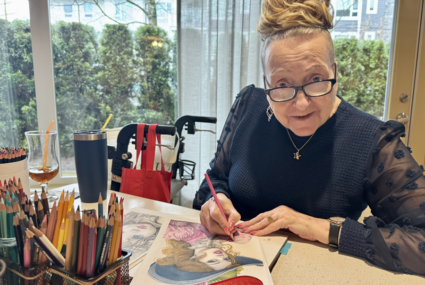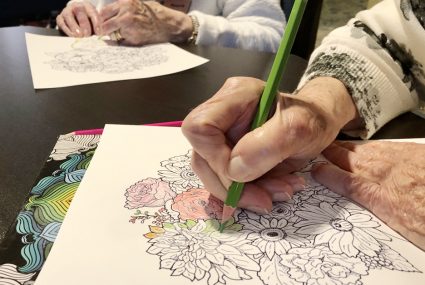Colouring has made a big comeback! It’s no longer just for kids but has also gained popularity among adults and seniors! It’s easy to see why. Whether it’s the soothing rhythm of filling in shapes, the delight of experimenting with colour, or the chance to share your creations with others, colouring is a simple way to creatively engage your brain
Here are six ways seniors can benefit by getting engaging in colouring.
1. A Natural Stress Reliever
Much like reading a good book, sitting down with a colouring book can help melt away stress. The repetitive motion, soft focus, and calming effect of colours create a meditative state. Colouring offers a gentle mental break — perfect for clearing the mind and refocusing on the present moment. As your hand moves across the page, your breathing may slow, your muscles relax, and the worries of the day melt away.
2. Accessible for Everyone
Talent and skill are not required! You don’t need to be an artist to enjoy colouring. With endless designs to choose from — animals, gardens, geometric patterns, and more — you can explore colour, texture, and style in your own unique way. For seniors with limited access to physical activities due to mobility or health challenges, colouring provides a rewarding and accessible creative outlet.
3. Supports Healthy Aging
Colouring activates many of the Seven Dimensions of Wellness, including, physical, intellectual, emotional and even spiritual. It can benefit hand-eye coordination, fine motor skills, and concentration. It also encourages mindfulness and stimulates the brain in a gentle, enjoyable way. Working on a colouring page is the equivalent of a workout that supports your overall wellness!
4. Variety Stimulates Your Brain
One of the hidden joys of colouring is the wide range of tools you can use — from soft wax crayons to vibrant markers, from detailed pencil crayons to smooth-blending alcohol pens and even your digital tablet. Each tool offers a different sensory experience. Trying out different mediums involves decision-making, experimentation, and a touch of problem-solving — all excellent ways to keep the mind active and alert.
5. A Creative Way to Connect with Others
Colouring is a fun and low-pressure social activity. Whether sitting around the table with friends, participating in a group class, or colouring with your grandchildren, it’s a beautiful way to bond. Sharing finished pages, colour ideas, and even a few laughs makes the experience richer for everyone.
6. Comforting In Cognitive Decline
For individuals living with dementia, colouring can be both soothing and stimulating. Unlike many tasks, it doesn’t rely on memory or require complex steps. It offers freedom, creativity, and comfort. Therapeutic colouring books — like those developed by dementia specialist Karen Tyrell — even help caregivers and loved ones connect through shared moments of calm and creativity.
Whether you’re at home or on the road, colouring can go with you.. Colouring apps on your tablet offer adjustable features for easier viewing, and give you the option to pick up your colouring any time without making a mess. So, pick up a colouring book, grab some coloured pencils, alcohol pens or even a crayon — and discover the peaceful, joyful world of colouring. It’s never too late to add a little more colour to your life.


Comments